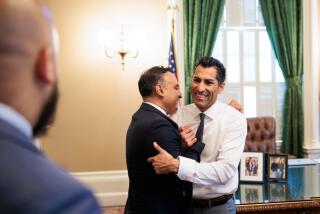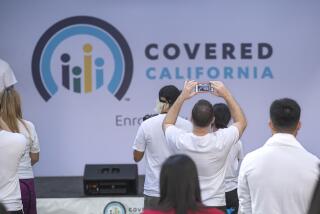Officials race to explain healthcare law to Californians
Louis Ramos wants health insurance for himself and his three children, so the single father stood in line at a recent East Los Angeles health fair, waiting to learn more about President Obama’s healthcare law. Ramos didn’t know if he qualified or how to sign up.
Ramos and many of California’s 7 million uninsured are eager to find out what the Affordable Care Act will mean for them. But just days before enrollment begins Oct. 1, there is still widespread confusion.
Some of it stems from the political fight that continues to rage in Washington, prompting people to wonder whether the overhaul could still be derailed.
To cut through the partisan bickering, California officials are racing to explain the law, especially to young, healthy people less likely to sign up. They know that young consumers are crucial to the law’s success to balance out older, sicker people expected to get insurance immediately.
Officials and outreach workers are knocking on doors, hosting health fairs and running phone banks to get the word out about what’s coming and persuade consumers to enroll.
California has been ahead of other states at putting the law into practice, creating the nation’s first insurance marketplace of different policies and getting an early start on expanding coverage to low-income people. But some experts say the hardest work has just begun in trying to explain a complicated law to the masses.
“People won’t rush right in,” said Sara Rosenbaum, a professor at George Washington University School of Public Health. “This will take a while.”
Two-thirds of uninsured people say they still don’t have enough information about the health law to understand how it will affect their own family, according to a new national poll by the Kaiser Family Foundation.
California began running ads this month on television, radio, buses and billboards, encouraging people to get covered. State call centers are fielding hundreds of consumer questions. Community groups, insurance companies, unions and health clinics have dispatched workers to tell people about the changes ahead.
They have a lot of ground to cover. Although online enrollment will be available, officials predict that as many as 80% of potential applicants will need one-on-one help to understand a new array of healthcare options and rules. By the end of next year, the state wants to have placed 1.2 million people in subsidized private plans and an additional 1.1 million in an expanded Medi-Cal program.
Federal subsidies will be available to make coverage more affordable for many. All consumers will be guaranteed coverage regardless of pre-existing medical conditions.
Given the state’s size and diversity, Covered California, the new insurance marketplace, says it needs about 16,000 enrollment counselors statewide. But fewer than 1,000 of those workers had been approved as of last week.
Those eligible for subsidized coverage speak dozens of languages and come from many different socioeconomic backgrounds, all of which makes outreach and enrollment more difficult.
“We have a population that is so mixed,” said Lucien Wulsin, head of the Insure the Uninsured Project in Santa Monica. “It is such a complex county.”
Over the next three months, according to the state, 7,300 outreach and education events are planned, including cultural festivals, community health fairs and presentations at churches.
The effort is concentrated in neighborhoods such as East Los Angeles, which has a large Latino population.
“This is ground zero,” said Peter Lee, Covered California’s executive director. After years of misinformation from critics, Lee said, it’s time to “talk about what the law is, how it will benefit Californians and what the costs are.”
Hundreds of residents flocked to last weekend’s health fair at an East Los Angeles middle school, where they could get their blood pressure and vision checked while children had their faces painted and entered a contest to win a bike.
Ramos came with plenty of questions. The 43-year-old hasn’t been insured since losing his job last year at a trucking firm. Without insurance for himself and his three children, ages 8, 7 and 5, he said he’s been “walking on egg shells” in hopes of avoiding the emergency room and big medical bills.
At the health fair, frustration soon set in after he was sent to three different places before arriving at a small booth for Covered California. Celia Valdez, an outreach worker, greeted him with her standard line: “Do you have health insurance?”
Ramos explained his situation and jumped to his biggest question, “How much would I pay?”
There wasn’t a computer available to check the state’s online rate calculator. Depending on his income, Valdez said, Ramos could qualify for coverage at less than $100 a month.
“What if I don’t get Obamacare?” Ramos asked, suggesting he might wait until he found work again.
Valdez told him he could face an initial penalty of $95 or 1% of his income, whichever is greater.
Ramos left with mixed emotions. “I think it will be worth it,” he said. “But I don’t want to enroll before I get more information. The numbers aren’t clear.”
At another event last week in Commerce, organizers with SEIU-United Healthcare Workers explained the law and helped some start the enrollment process. Dozens of uninsured residents sat in chairs, listening to music and waiting to talk to counselors about their options. The room was decorated with signs in English and Spanish — “Are you ready for Obamacare?”
At one table, consumers could jot down the craziest things they had heard about Obamacare. One wrote that you could get fired if you don’t get insurance. Another wrote that you can’t be treated at a hospital without coverage. Organizers said they are trying to debunk those myths and tell people — in English and Spanish — how the law will work.
Alejandro Gomez, 19, attended the event to see whether he might qualify for insurance so he could stop using cash to pay for medical visits. Gomez said he was aware of Obamacare but didn’t know any details. “I haven’t heard much, honestly,” he said. “I just heard it was kind of mandatory.”
Another uninsured person, Russell Fung, 29, who works as a film editor and production assistant, said he also wanted to find out whether he was eligible for discounted insurance. Fung said he has knee and back problems and really needs coverage.
Fung learned during the event that he wasn’t eligible for Medi-Cal because he earned too much money but that he might be able to receive subsidized insurance through Covered California. An SEIU worker directed him to the state’s website, https://www.coveredca.com, for more information.
State leaders are asking the public to be patient during the initial rollout.
“One thing I can guarantee is we won’t get everything right,” said Robert Ross, a Covered California board member and chief executive of the California Endowment. “We will have bumps in the road.”
More to Read
Start your day right
Sign up for Essential California for news, features and recommendations from the L.A. Times and beyond in your inbox six days a week.
You may occasionally receive promotional content from the Los Angeles Times.







